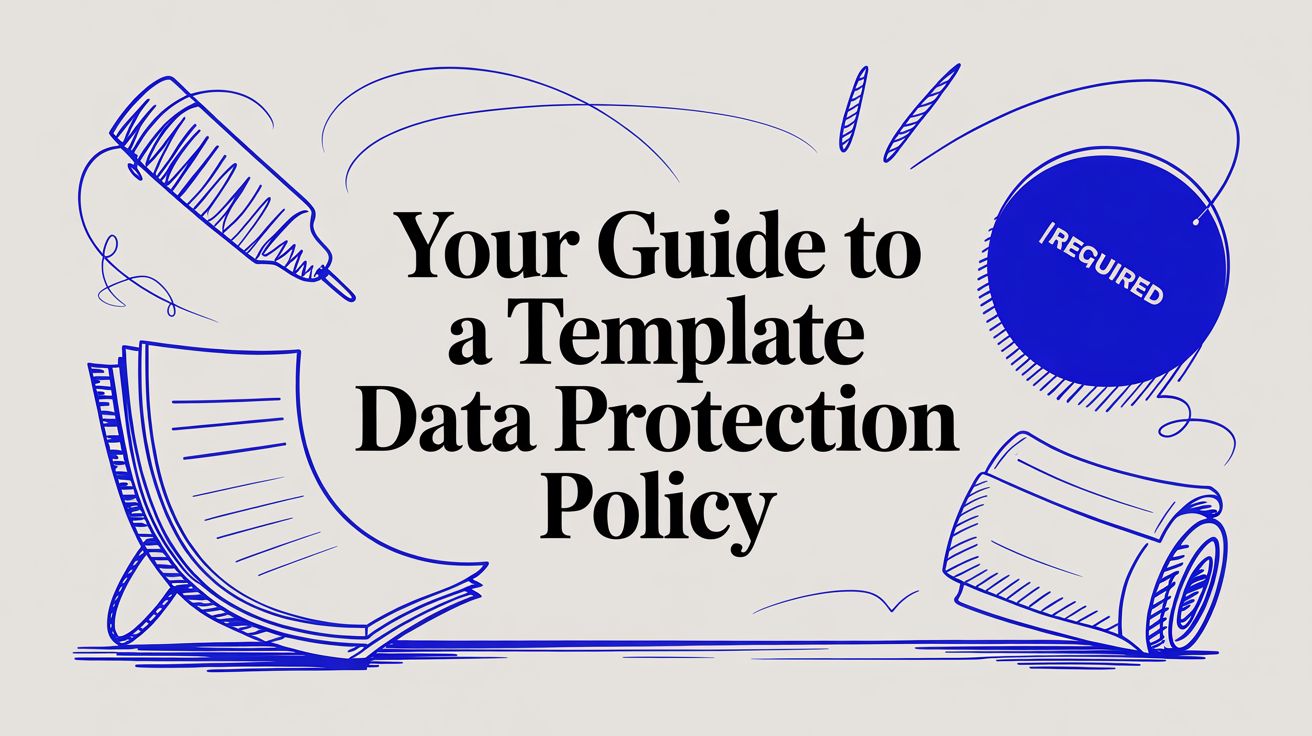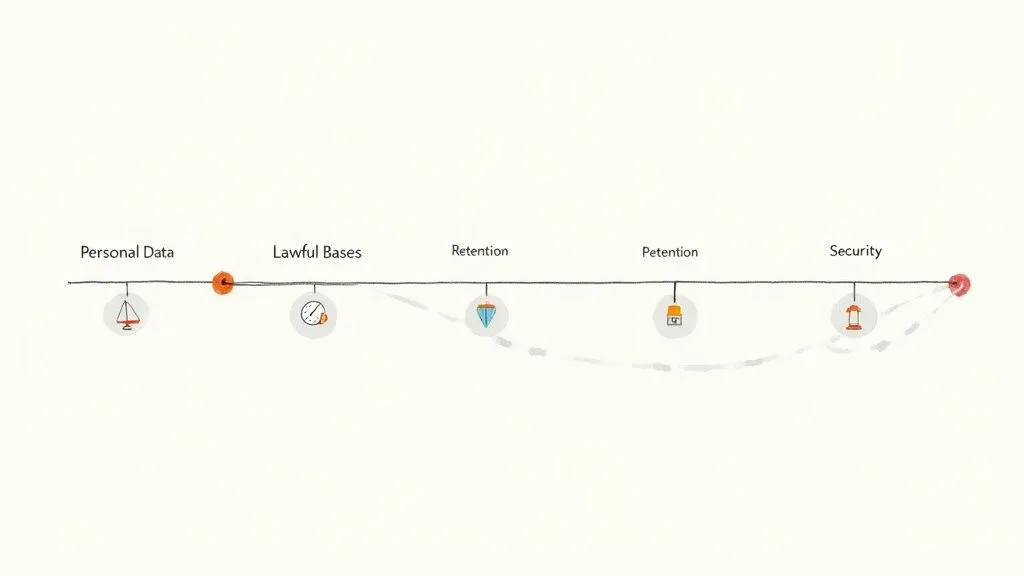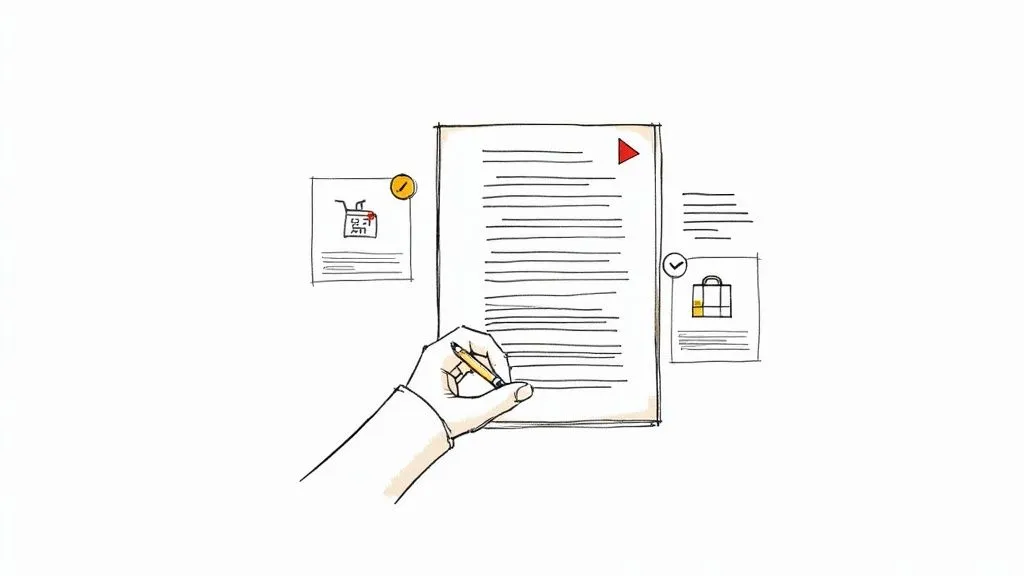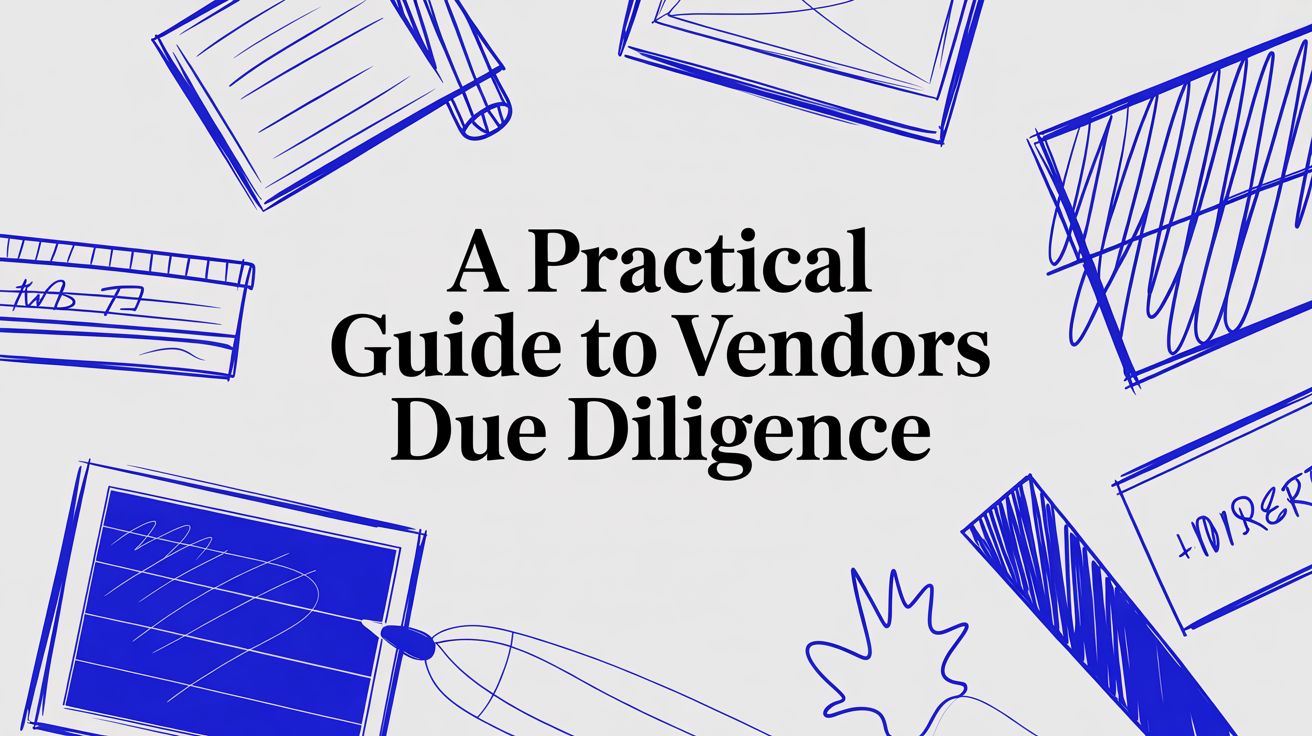· Jane Iamias · template data protection policy · 23 min read
Your Guide to a Template Data Protection Policy
Use our template data protection policy to build a GDPR-compliant framework. Learn how to customise, implement, and maintain your UK data security.

A good template data protection policy offers a solid foundation for compliance, but I can’t stress this enough: it’s only the starting point. I’ve seen too many businesses download a generic document, slap their name on it, and assume they’re covered. This is a significant risk that leaves your organisation completely exposed.
The real work—and the real value—comes from turning that template into a policy that genuinely reflects your unique data handling practices.
Why a Generic Template Is Not Enough

Starting with a template is a smart move. It saves you from reinventing the wheel and ensures you cover the core components required by regulations like the UK GDPR. However, the most common—and dangerous—mistake is stopping there. A generic policy just can’t account for the specific ways your business operates.
Think about it. What types of personal data do you actually collect? Which third-party services are integrated into your workflow? These details are unique to you, and the gap between a template and your reality creates serious compliance vulnerabilities.
Regulators, like the Information Commissioner’s Office (ICO) here in the UK, expect policies to be accurate and specific. A generic document just signals that data protection is a tick-box exercise for you, not an integral part of how you do business.
The Risks of a One-Size-Fits-All Approach
From my experience, relying on an unedited template can lead to serious financial and reputational damage. Every business has a unique data footprint, and your policy must mirror it precisely.
Here are a few common pitfalls I’ve seen:
- Inaccurate Data Descriptions: Your business might collect unique data types—say, biometric information from a time-tracking system or location data from a mobile app. A generic template would never include these specific categories.
- Mismatched Lawful Bases: A template will likely list all six lawful bases for processing under UK GDPR. If your company only relies on consent and contractual necessity, listing the others is misleading and inaccurate.
- Vague Security Measures: It’s easy for a template to say you use “appropriate technical measures”. But regulators, partners, and savvy customers want to know what those measures are. Are you using end-to-end encryption? Multi-factor authentication? Granular access controls?
- Incorrect Third-Party Disclosures: You have to name the specific analytics tools, cloud storage providers, or payment processors you use. A generic policy can’t list your actual vendors, leaving you non-compliant.
A data protection policy isn’t just a legal document; it’s a promise to your customers. A generic policy makes a vague promise, but a customised one provides a credible guarantee that you’re handling their data with care.
Moving Beyond the Template to Build Trust
Ultimately, your goal is to create a living document that is both compliant and genuinely useful. A well-crafted data protection policy does more than just satisfy legal requirements; it builds trust with your customers and partners.
When people can read a policy that clearly and accurately describes how their information is handled, their confidence in your brand grows. It shows you respect their privacy and have nothing to hide.
This guide provides a foundational template data protection policy, but its main purpose is to walk you through customising it effectively. We’ll go through, section by section, how to transform it from a generic starting point into a robust, specific, and trustworthy document that strengthens your business.
Understanding Your Data Protection Policy

Before you start customising any template data protection policy, it’s vital to get to grips with its anatomy. A good template gives you the skeleton, but you need to understand the purpose of each bone to build a strong, functional framework that genuinely fits your organisation. This is about more than just filling in blanks; it’s about grasping the ‘why’ behind each clause.
Think of the policy as your roadmap to compliance. Every section is there for a reason, usually to meet specific requirements from regulators like the Information Commissioner’s Office (ICO) or to build trust with your customers. Taking the time to demystify this structure now will give you the confidence to make meaningful, effective changes later.
Defining the Core Terminology
The first part of any decent data protection policy always sets the stage by defining key terms. This isn’t just legal boilerplate. Its real purpose is to establish a common, unambiguous language for everyone in your company. When everyone understands their obligations in the same way, you drastically reduce the risk of mistakes.
You’ll need to clearly define terms like:
- Personal Data: This is any information relating to an identifiable person. It’s much broader than most people think, including things like IP addresses and cookie identifiers, not just the obvious names and email addresses.
- Data Subject: In simple terms, this is the individual whose personal data you’re processing—your customers, employees, or even just website visitors.
- Processing: This is a catch-all term for virtually anything you can do with data, from collecting and storing it to analysing, sharing, and eventually deleting it.
- Data Controller: That’s you—your organisation. You’re the one deciding the “why” and “how” of the data processing.
Nailing these definitions is the foundation of your entire policy. It ensures that when you talk about “personal data,” your team knows exactly what that covers.
The Seven Key Principles of Data Processing
At the very heart of the UK GDPR are seven core principles. These aren’t suggestions; they are mandatory rules that must guide every single one of your data-handling activities. Your policy has to do more than just list them; it needs to show how your organisation actively puts them into practice. They are your ethical and legal compass.
These principles dictate that all data processing must be:
- Lawful, fair, and transparent: You must have a solid legal reason for processing data and be completely open about what you’re doing.
- Purpose limitation: Only collect data for specific, explicit, and legitimate purposes that you’ve clearly stated from the outset. No mission creep.
- Data minimisation: Only collect and process as much data as is absolutely necessary for the job at hand.
- Accuracy: You have to ensure personal data is kept accurate and up-to-date.
- Storage limitation: Don’t hang onto personal data forever. Keep it only for as long as you genuinely need it.
- Integrity and confidentiality (security): You must actively protect data against unauthorised access, loss, or destruction.
- Accountability: This is the big one. You are responsible for proving that you comply with all the other principles.
Your policy is the main way you demonstrate accountability. It’s your evidence. For a real-world example of how these principles can be communicated clearly, take a look at Formbricks’ Privacy Policy to get some ideas for structuring your own document.
Lawful Bases: The Legal Gateway to Processing
Here’s a non-negotiable point: you cannot legally process personal data without a valid reason, known as a “lawful basis.” Your policy must explicitly state which of the six available bases you rely on for your different processing activities. Crucially, you must decide on the right one before you even start processing.
Choosing the right lawful basis is not an administrative afterthought; it’s a fundamental requirement that determines an individual’s rights. For example, if you rely on consent, individuals have a strong right to withdraw it at any time.
For most businesses, the common bases you’ll rely on are:
- Consent: The individual has given you clear, unambiguous permission to process their data for a specific purpose.
- Contract: The processing is essential for a contract you have with the individual (e.g., processing an address to deliver a product).
- Legitimate Interests: The processing is necessary for your legitimate business interests, so long as these don’t override the fundamental rights and freedoms of the individual.
It’s crucial to document which basis applies to each of your processing activities. For instance, you might use ‘contract’ to process a customer’s address for delivery but rely on ‘consent’ for sending them marketing newsletters.
To help you piece this all together, the table below summarises the key sections you’ll find in a comprehensive policy and explains what they’re there for.
Key Sections of a Data Protection Policy and Their Purpose
| Policy Section | Core Purpose | Relevant Regulation (UK GDPR) |
|---|---|---|
| Introduction & Scope | Defines what the policy covers, who it applies to, and key terminology. | Article 5 (Accountability) |
| Data Protection Principles | Outlines commitment to the seven core principles of data processing. | Article 5(1) |
| Lawful Bases for Processing | Explains the legal grounds your organisation relies on to process data. | Article 6 |
| Data Subject Rights | Details the eight rights individuals have over their data and how to exercise them. | Articles 12-23 |
| Data Security Measures | Describes the technical and organisational measures in place to protect data. | Article 32 |
| Data Retention Schedule | Specifies how long different types of data are stored and why. | Article 5(1)(e) |
| Roles & Responsibilities | Clarifies who is responsible for data protection within the organisation. | Article 24 |
Having this breakdown in mind will make the process of tailoring our template far more intuitive and ensure your final policy is both compliant and practical.
How to Customise Your Policy Template

Right, this is where the real work kicks in. Taking a generic template data protection policy and turning it into a document that actually reflects your business is the most important part of the whole process. This is about moving from legal theory to practical reality, making sure the policy is a genuine guide for your team, not just a file gathering dust on a server.
It’s about more than just slotting your company name into a few gaps. You need to take a hard look at your specific data-handling practices. We’ll walk through the key customisation points with some real-world scenarios to make things clear and actionable. The aim is to create a policy that’s not only compliant but genuinely useful.
Define Your Data Collection and Purpose
First things first: you need to spell out exactly what personal data you collect and, crucially, why you collect it. Vague phrases like “customer information” just won’t cut it. To meet the transparency principle, you have to get granular.
Think about every single point where you gather data. This means mapping out your data flows, from the very first contact with a person right through to the end of their journey with you.
For an e-commerce shop: You’re likely collecting names, shipping addresses, payment details, email addresses, and phone numbers. The purpose here is pretty clear: to get orders out the door, take payment, and keep customers in the loop about their purchase. But you might also collect browsing history to recommend products—that’s a separate purpose that needs to be clearly stated.
For a B2B SaaS platform: You’ll be gathering user data like names, work emails, and job titles for setting up and managing accounts. You’ll probably also process usage data to improve your service or help with support tickets. Each of these is a distinct purpose that needs to be documented.
Be meticulous. List every category of data and link it directly to a specific, legitimate business need. This clarity isn’t just for the regulators; it helps your own team understand the ‘why’ behind their data responsibilities.
Documenting Your Lawful Bases
Once you’ve mapped out what you’re doing with data, you have to assign a valid lawful basis to each activity. As we’ve covered, processing data without one is a non-starter. This is a common pitfall where generic templates can lead you astray.
Let’s put this into practice. Imagine a digital marketing agency.
Client Onboarding: When a new client signs on, the agency processes the contact details of their staff. The lawful basis here is Contractual Necessity because this data is essential to deliver the marketing services they’ve agreed to.
Marketing Newsletter: The agency sends out a monthly newsletter with industry tips. For anyone who isn’t a client but signed up on the website, the lawful basis is Consent. The agency must have a clear record of them opting in.
Lead Generation: The agency might process data on potential business leads from public sources like LinkedIn. In this case, they could rely on Legitimate Interests, but they would need to have carried out a Legitimate Interests Assessment (LIA) to weigh their interests against the individual’s rights.
Your policy has to explicitly state which basis applies to each thing you do with data. Just listing all six lawful bases isn’t enough—you have to connect them directly to your real-world operations.
Articulating Data Retention Schedules
No business can hang on to personal data forever. The principle of ‘storage limitation’ means you only keep it for as long as necessary. Your policy needs a crystal-clear data retention schedule that sets out these timeframes.
This is another area crying out for customisation. A template might vaguely say “as long as legally required,” but you need to define what that actually means for your company. While customising your data protection policy, it’s a good idea to look at a document retention policy template to keep things consistent across all your internal rules.
Here are a few common examples:
- Financial Records: Invoices and payment records must be kept for six years plus the current financial year for UK tax purposes.
- Customer Accounts: You might decide to keep data for as long as an account is active, plus a set period afterwards (say, 24 months) to handle any final queries, unless the user asks for deletion sooner.
- Unsuccessful Job Applications: CVs and interview notes for candidates who didn’t get the job should typically be deleted within six months.
Your policy should lay these periods out in a table or a clear list for different data types. This shows you’ve thought it through and are taking accountability.
Outlining Specific Security Measures
Your policy must describe the “technical and organisational measures” you use to protect data. This is a core part of the UK GDPR’s integrity and confidentiality principle. And again, vague statements won’t do.
You don’t need to give away security secrets that could be exploited, but you do need to provide enough detail to be transparent and build trust.
Instead of saying: “We use appropriate security measures.”
Try being more specific:
- Technical Measures: “We protect personal data through measures including end-to-end encryption for data in transit, AES-256 encryption for data at rest, multi-factor authentication for access to all critical systems, and regular vulnerability scanning.”
- Organisational Measures: “Access to personal data is restricted on a need-to-know basis, all staff receive mandatory annual data protection training, and we maintain a comprehensive incident response plan.”
This level of detail proves you’ve actively put robust security controls in place—which is exactly what regulators, and your customers, want to see.
Staying Current with Legislative Changes
Data protection law doesn’t stand still. Your policy has to be a living document, ready for updates as regulations evolve. The UK’s data protection landscape, for example, is always shifting.
A major development on the horizon is the UK’s Data (Use and Access) Act 2025, which tweaks parts of the current framework to encourage innovation while keeping standards high. One key change is a new lawful ground for processing data specifically for crime prevention, giving businesses clearer authority here. Your policy should include a clause committing to regular reviews—at least once a year—and updates to stay in line with these kinds of legislative changes.
Handling International Data Transfers Correctly
In our connected world, data rarely sits still. If you use cloud services hosted in Dublin, work with suppliers in India, or have customers in the US, personal data is almost certainly crossing borders. That’s why getting international transfers right in your template data protection policy is absolutely critical.
Getting this wrong is a huge compliance blind spot. Regulators are all over this, and for good reason. Once personal data leaves the UK, it can fall outside the protection of our robust laws. Your policy must show exactly how you keep that data safe, no matter where it ends up.
The Easy Route: Adequacy Decisions
The simplest way to move data across borders is to send it somewhere the UK government has already given a green light. These are countries with an ‘adequate’ level of data protection, and the official approval is known as an adequacy decision.
Think of these decisions as a legal bridge. They allow data to flow freely to approved countries without you needing to jump through extra hoops. This list of approved places includes:
- The entire European Union (EU): A massive relief for anyone doing business between the UK and Europe.
- Other approved nations: A growing list that includes places like Canada (for commercial organisations), New Zealand, and Switzerland.
Your policy should make it clear that you prioritise sending data to countries with a UK adequacy decision whenever you can. It’s a foundational piece of the puzzle. This streamlined flow is a two-way street. The strength of the UK’s own data protection framework was recently highlighted when the European Data Protection Board (EDPB) decided in 2025 to extend the UK’s adequacy status under EU GDPR until December 2031. This extension, a major benefit for cross-border operations, means EU organisations can keep transferring data to the UK without facing additional legal hurdles. You can discover more insights about this EDPB decision and what it means for UK businesses.
When There’s No Adequacy Decision
So, what happens when you need to send data to a country that isn’t on the ‘adequate’ list, like the United States or India? This is an everyday scenario for most businesses using popular software or cloud services. Here, you have to put specific legal safeguards in place.
Your policy needs to spell out which mechanisms you’re using. For most UK businesses, the go-to tool is the International Data Transfer Agreement (IDTA). This is a standard contract, approved by the ICO, which legally obligates the organisation receiving the data to protect it to UK GDPR standards.
Think of the IDTA as a legally enforceable promise. The company receiving the data signs on the dotted line, agreeing to handle it with the same level of care and security as if they were right here in the UK.
You have to explicitly name the safeguards you rely on for these ‘restricted transfers’ in your policy.
Documenting Your Approach
Being transparent is non-negotiable. This section of your data protection policy needs to clearly document how you handle international transfers. It’s not just about satisfying lawyers; it builds trust with your customers, staff, and partners.
Here’s what you need to cover in your customised policy:
- A straightforward statement outlining your process for international data transfers.
- The specific tools you use for transfers to non-adequate countries, like the IDTA.
- A commitment to carrying out a Transfer Risk Assessment (TRA) before sending data to a non-adequate country. This assessment ensures the contractual promises can actually be met in practice.
By detailing these steps, you take a generic template and turn it into a concrete statement about your company’s commitment to global data protection. You’re showing that you don’t just tick boxes—you have a real framework for keeping data secure, wherever it goes.
Bringing Your Data Protection Policy to Life

You’ve done the hard work and customised your data protection policy template. That’s a massive step, but its true value only comes when it leaves the page and gets woven into your daily operations. A policy that just gathers dust on a digital shelf is worthless.
Now comes the critical part: embedding it into your company culture. The aim is to turn that static document into a dynamic guide that actively shapes how your team behaves. This is about more than just firing off a company-wide email with a PDF attachment. It requires a proper rollout plan—one that covers communication, training, and integrating the policy with the procedures your teams already follow.
The end goal is simple: everyone needs to understand their specific responsibilities and see data protection as a core part of their job, not just another compliance headache.
Effective Staff Training and Communication
You can’t expect your team to follow a policy they don’t really understand or, worse, haven’t even read. Training is the bridge between the words in the document and the actions your people take every day. Forget vague, tick-box training sessions; they’re a complete waste of time. You need to make the information relevant to people’s actual jobs.
Your sales team, for example, needs to know the correct lawful basis for adding a prospect to your CRM. The marketing department absolutely must understand the latest rules around email consent.
- Role-Specific Scenarios: Use real-world examples that resonate. For a customer support agent, walk them through handling a data subject access request. For a developer, talk about the importance of privacy by design when they’re building a new feature.
- Clear Communication Channels: Announce the new policy through every channel you have—email, team meetings, your internal wiki, or Slack. Don’t just share it; highlight what’s new, what’s changed, and crucially, explain why it matters to them and the business.
- Accessibility: Make the policy ridiculously easy to find. It should have a permanent, central home where staff can refer to it whenever a question pops up.
Public awareness around data privacy has shifted dramatically since the UK GDPR came into force. Recent figures show that 62% of UK citizens now feel safer sharing their personal data. However, the same research reveals that around 30% of European businesses are still non-compliant, often because of a huge gap between policy and practice. Good training and a culture of awareness are your best defence. You can read the full research about data privacy perceptions to get a better handle on this.
Establishing a Policy Review Cycle
Data protection isn’t a “set it and forget it” task. Your policy must be a living document that evolves with your business and the shifting regulatory landscape. If you don’t have a formal review cycle, you’re just waiting for it to become outdated and non-compliant.
Best practice is to schedule a full review annually, but certain events should trigger an immediate update.
Think of your data protection policy like a piece of software—it needs regular updates and patching. An out-of-date policy is a critical vulnerability waiting to be exposed.
So, when should you conduct an ad-hoc review?
- After a Security Incident: A data breach or even a near-miss provides invaluable, if painful, lessons. Update your policy to reflect any new controls or procedures you’ve put in place to stop it from happening again.
- Introduction of New Technology: Rolling out a new CRM, a new analytics tool, or any system that touches personal data? Your policy has to be updated to cover it.
- Changes in Regulations: When laws like the UK GDPR are amended or the ICO issues new guidance, your policy must be revised immediately to stay on the right side of the law.
Integrating with Other Critical Procedures
Your data protection policy can’t exist in a bubble. For it to be truly effective, it must be stitched into the fabric of your other operational procedures. This is how you ensure data protection principles are applied consistently right across the organisation.
Your Incident Response Plan, for instance, is the perfect partner to your data protection policy. When a security incident strikes, the policy defines what counts as personal data, while the response plan dictates the exact steps to contain and report the breach, as mandated by the policy.
Likewise, your Vendor Management Process must include data protection checks. Before you onboard any new third-party service, you have to assess their security and privacy practices to make sure they meet the standards you’ve set in your own policy. When you connect these dots, you create a data protection framework that’s cohesive, robust, and actually works.
Common Questions About Data Protection Policies
Getting your head around data protection can feel like wading through a sea of acronyms and dense legal text. It’s completely normal to have questions, and I get asked a lot of them, especially from people adapting a template data protection policy for the first time. Let’s tackle some of the most common ones I hear.
What’s the Difference Between a Privacy Notice and a Data Protection Policy?
This is easily one of the most frequent points of confusion, but the distinction is crucial. The simplest way to think about it is internal versus external.
- A Data Protection Policy is your internal rulebook. It’s for your team, laying out the ground rules, procedures, and who’s responsible for what when it comes to handling personal data. It’s all about making sure your staff get it right.
- A Privacy Notice (often called a Privacy Policy) is your external, public-facing statement. This is the document you show customers, website visitors, and anyone else whose data you collect. It explains what data you’re gathering, why you need it, and what you’re doing with it.
So, your internal policy dictates your team’s actions, while your external notice keeps you transparent with the outside world, which is a core legal requirement.
How Often Should I Update My Policy?
There isn’t a single, hard-and-fast rule written into law, but a full, formal review at least once a year is considered best practice. That said, some events should trigger an immediate review, no matter how recently you last looked at it.
Think of it as a living document. You’ll need to dust it off and make updates whenever:
- You bring in new software or systems that handle personal data.
- Your business operations change, and you start collecting different kinds of data for new reasons.
- The laws themselves change, or regulators like the ICO release new guidance.
- You’ve had a data breach or a near-miss. This is a critical time to learn lessons.
An outdated policy is a non-compliant policy. It has to evolve as your business and the rules of the game evolve.
What Happens if an Employee Violates the Policy?
When a team member doesn’t follow the policy, you’re looking at a serious situation that could easily become a data breach. Your policy needs to be crystal clear that non-compliance will lead to disciplinary action. This could be anything from mandatory retraining to dismissal, depending on how serious the mistake was.
When a violation happens, your incident response plan should kick in immediately. The typical steps look something like this:
- Contain the breach. Stop any further unauthorised access or data loss right away.
- Assess the damage. Figure out the potential risk to the people whose data has been exposed.
- Report it. You must report the breach to the ICO within 72 hours if there’s a risk to people’s rights and freedoms.
- Inform the individuals. If the breach is likely to result in a high risk, you need to tell the people affected directly.
Having a clear, well-rehearsed process for handling these incidents is fundamental. It not only helps you manage the immediate risk but also demonstrates to regulators that you are accountable.
Accelerate your security reviews and close deals faster with ResponseHub. Our AI-powered platform automates security questionnaires by using your existing documentation to provide precise, policy-referenced answers in minutes. Start your free trial today at https://responsehub.ai.
Article created using Outrank



